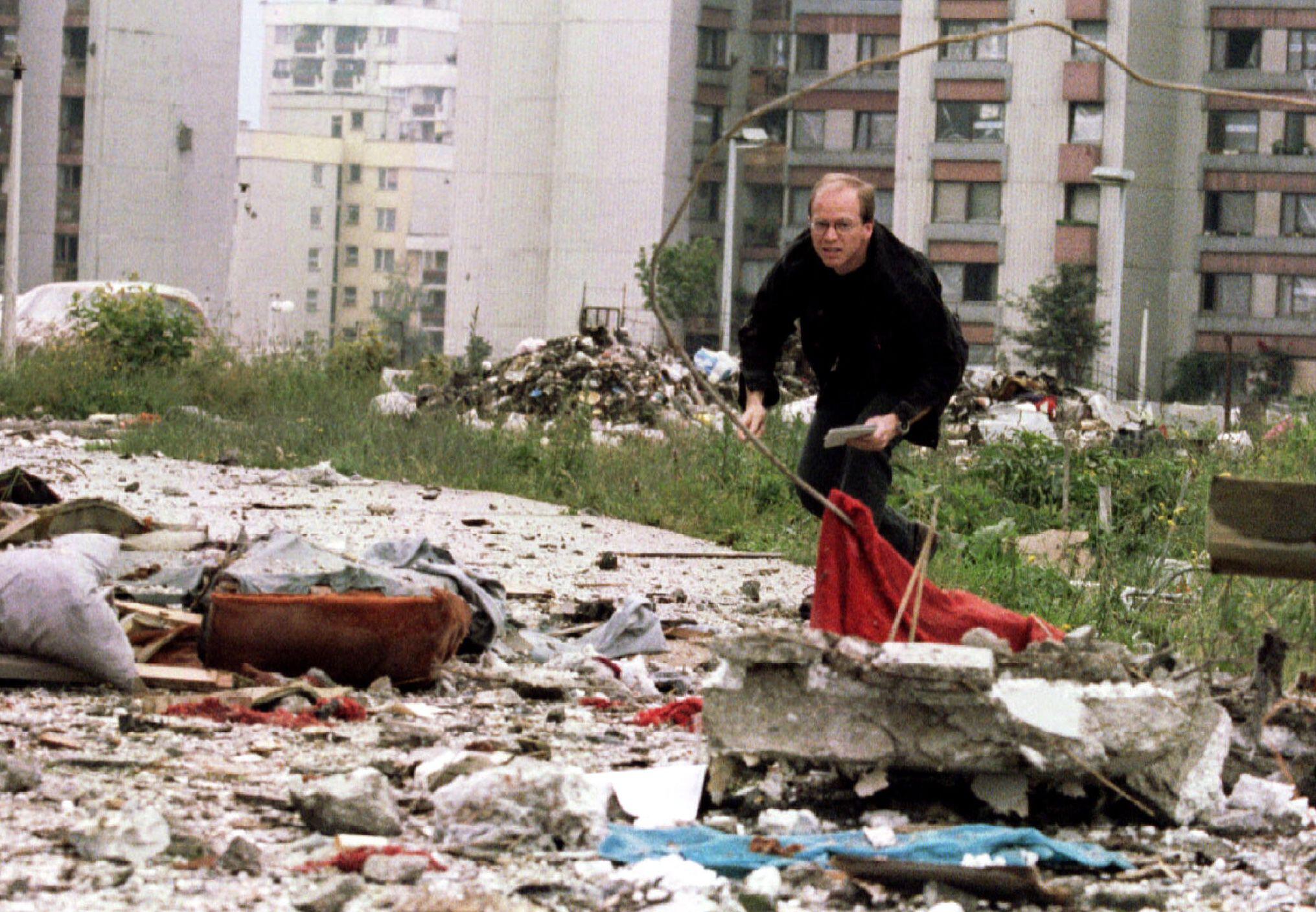The siege of Sarajevo revealed the vital importance of war reporting
News organisations drew worldwide attention to the siege and the war in Bosnia, which likely contributed to ending a conflict most world leaders would have preferred to ignore, writes Borzou Daragahi


They were seasoned, roving correspondents and veterans of prior wars backed by major news organisations. They were struggling young freelance journalists drawn by a dramatic and heartbreaking story. They risked their lives getting into the besieged city, and then, once in town, took further chances dodging snipers and mortars. A few were killed, more were injured. All were marked by the siege of Sarajevo, which began 30 years ago this year.
The work, lives and impact of the journalists who covered the Bosnian capital during those benighted years is chronicled and commemorated in Live From Sarajevo: How Foreign Journalists Covered the Siege, an exhibition of photos, videos and found objects now showing at the Historical Museum of Bosnia and Herzegovina.
“We wanted to present the voice of the internationals who were covering the war,” curator Elma Hodzic tells me during a tour of the exhibit. “These are the stories of the eyewitnesses.”
The brutal siege of Sarajevo by Serbian militias was a landmark event in the history of Europe. But it was also a key moment in journalism. Newly emerging digital technologies were improved and expanded. Generator-powered satellite hookups became a norm. Paramilitary gear such as armoured vehicles and bulletproof jackets became ordinary accoutrements of war coverage.
“By the late summer of 1992, it became commonplace to see journalists wearing flak jackets – with the journalist’s blood type prominently displayed on them, should they require a blood transfusion – and helmets,” the text of one display in the exhibit read.
The four-year blockade was the longest siege of a city in modern history. Some 14,000 people were killed, including at least 5,400 civilians. The once-lively Balkan city nestled within snow-covered mountains became a ghost town. But to much of the outside world, the conflict was confusing, and the stakes were murky. Weren’t people in that part of the world always killing each other?
Correspondents reporting from Sarajevo brought the horrific reality of the war into the living rooms of the rest of the world. But they also brought a measure of moral clarity about what would later be deemed genocidal war crimes, eventually leading to forceful international intervention, an end to the war, and a resurrection not just of Sarajevo, but of the notion of Bosnia-Herzegovina and a multi-ethnic, multi-confessional state.
It is worth remembering a moment when news organisations drew worldwide attention to the siege and the wider war in Bosnia. Media attention likely contributed to ending a conflict most world leaders would have preferred to ignore.
But the war also marked perhaps the first time that journalists were as imperilled as other civilians. At least 19 journalists were killed in the conflict, including Italians, Americans, a Briton, a German, a Turk and an Iranian as well as numerous Bosnians.
Even getting into Sarajevo was a challenge, with lucky journalists hitching rides from humanitarian relief flights and the less fortunate forced to sneak past Bosnian Serb positions surrounding the city.
One producer, ABC News’s David Kaplan, was killed by a sniper’s bullet that entered between the “T” and “V” taped to his car to denote the press. “The war was very cruel to locals but also to internationals,” says Hodzic. “No one could guarantee safety for the international journalists who came to Sarajevo.”
Among the exhibits is a giant photograph showing the bleak, shattered landscape of the city taken by Magnum Photos’ Gilles Peress through a broken window of the Holiday Inn, where many journalists stayed during the siege.
To gather stories, foreign journalists often relied on locals called fixers or stringers, and the Live From Sarajevo exhibition pays homage to those who worked alongside the visitors. Their language skills were important, but so was their ability to procure supplies, find power during blackouts, negotiate past checkpoints or obtain coveted permissions from local authorities.
In December 1992, Slobodanka Boba Lizdek was broke he walked into the Holiday Inn amid heavy shelling and quickly got a $100-a-day job translating for El Mundo, the Spanish daily. “I was not wearing a flak jacket,” he is quoted as saying in a display at the exhibit. “Not because I was irresponsible but because I was in my own city and among my own people. How could I talk to them when I had protection, purely because of my work, and they did not?”
Getting the story out of Bosnia was an enormous challenge. Forget 4G or even DSL. Back then in Bosnia, there were barely even dial-up internet connections, and journalists found themselves filing via shaky satellite phone lines or getting a hand sending footage out from the local television channels.
Journalists gathered regularly at the Postal, Telegraph and Telephone building for United Nations daily press briefings they jadedly dubbed “the nine o’clock follies” in reference to the disingenuous “five o’clock follies” held by American war commanders during the Vietnam conflict.
To keep up to speed with all the latest opinions and comment, sign up to our free weekly Voices Dispatches newsletter by clicking here
The exhibition is filled with artefacts from the war. It includes old cameras, bulky laptops, flak jackets, and even a crumpled ball of tape used by bored journalists to play football in the lobby of the Holiday Inn, which is just across the busy roadway from the museum. “The manager of the hotel saved the ball,” Hodzic says with a laugh,
Photographs show journalists relaxing together, but the exhibit also features some of the most iconic work by the journalists, including poignant articles written about life under siege. One photograph by British journalist Paul Lowe shows a solitary man pausing before deciding whether or not to risk his life before crossing through the deadly “Sniper’s Alley” beneath Bosnian Serb positions on mountaintops.
The exhibition, housed within a larger collection that chronicles life during the siege for ordinary Bosnians, comes at a particularly fraught time for the Balkan country. The peace deal that ended the war is being challenged and coming undone by a surge of ethnic nationalism as well as the accumulating weight of Bosnia’s own failures.
“Politicians are using the word ‘war’ a lot,” says Hodzic, a 32-year-old who lived her first years during the siege and grew up in the shadow of the conflict. “Presenting this exhibition at this moment we can remember what it means to be at war.”






Join our commenting forum
Join thought-provoking conversations, follow other Independent readers and see their replies
0Comments